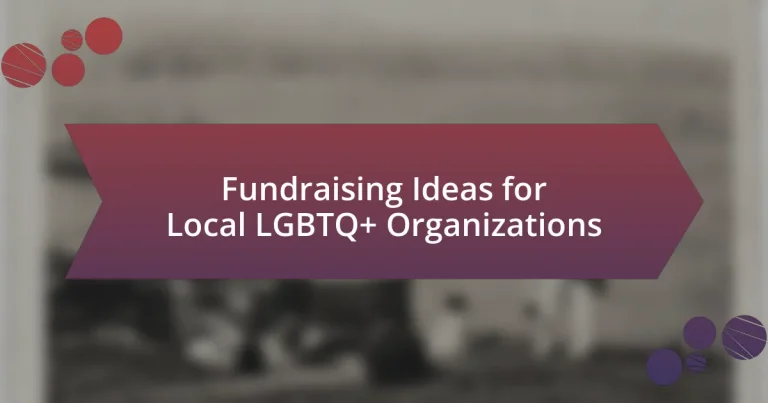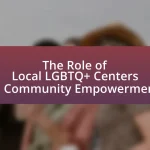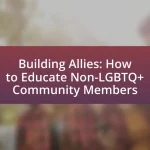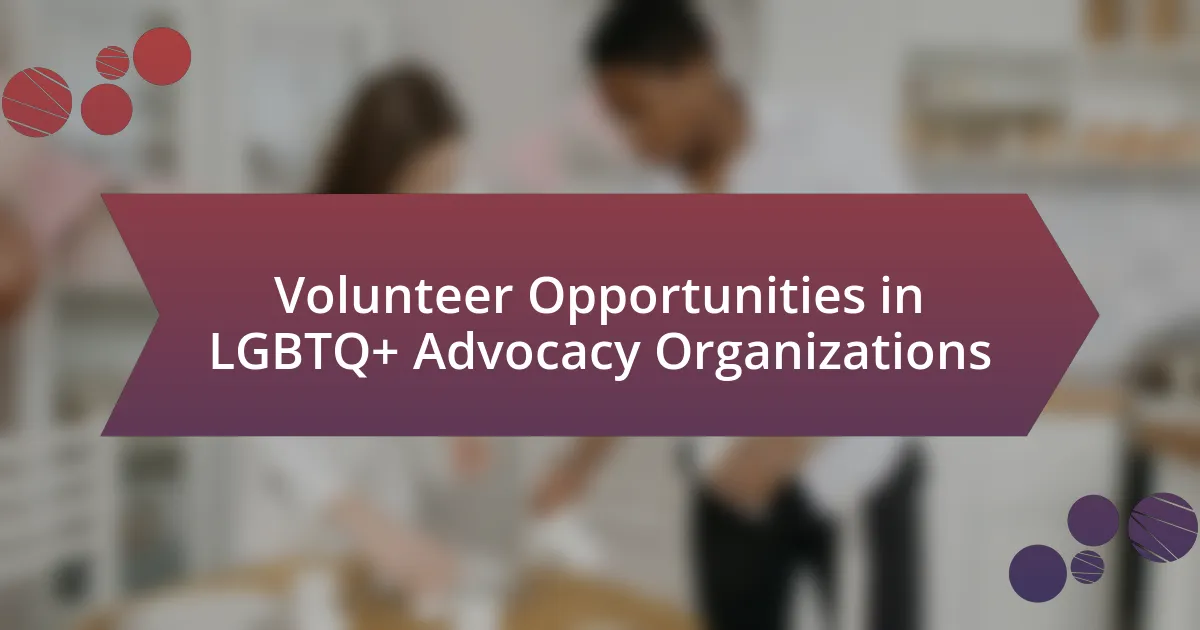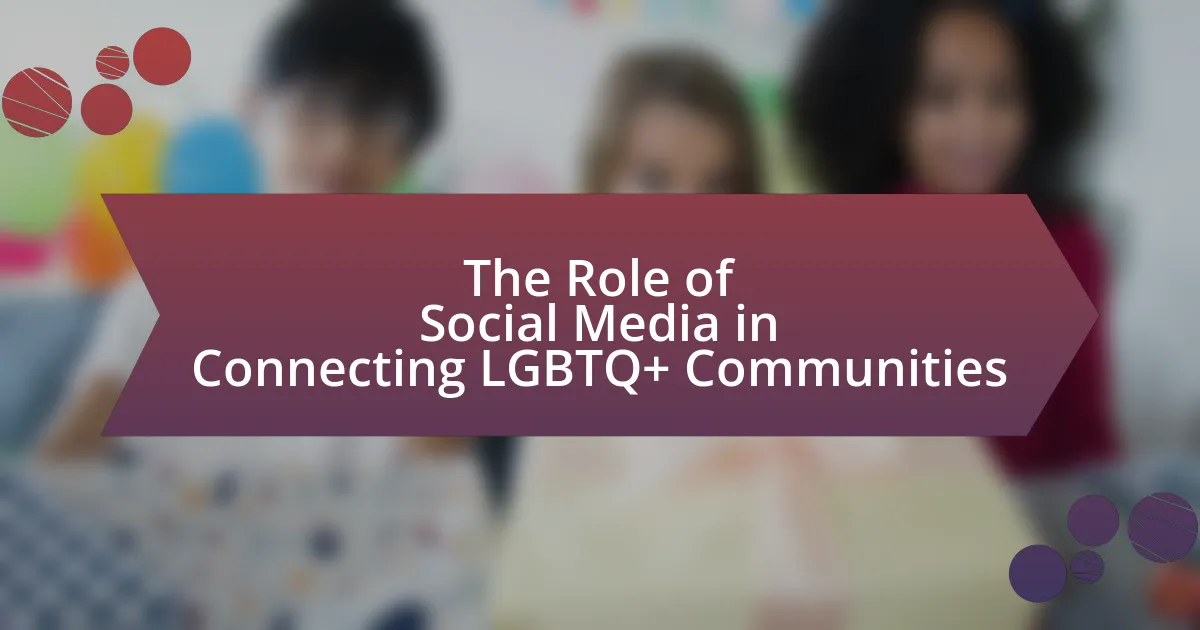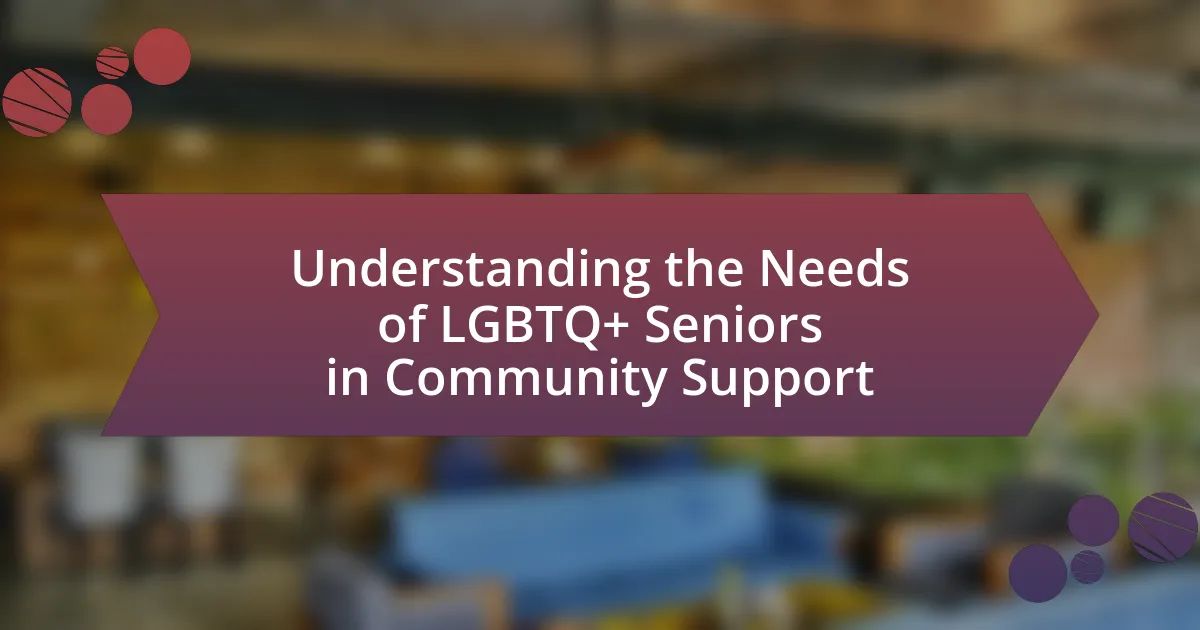The article focuses on effective fundraising ideas for local LGBTQ+ organizations, highlighting various strategies such as community events, online crowdfunding, and partnerships with local businesses. It outlines how organizations can assess their fundraising needs, set realistic goals, and prioritize initiatives based on mission alignment and potential impact. Additionally, the article discusses the importance of community engagement, the role of volunteers, and innovative approaches like social media campaigns and virtual events. It also addresses common challenges faced by these organizations and offers practical tips for maintaining donor relationships and effectively communicating their impact.

What are Effective Fundraising Ideas for Local LGBTQ+ Organizations?
Effective fundraising ideas for local LGBTQ+ organizations include hosting community events, such as pride festivals, drag shows, and art exhibitions, which not only raise funds but also foster community engagement. These events can attract diverse audiences and generate sponsorship opportunities from local businesses. Additionally, online crowdfunding campaigns through platforms like GoFundMe or Kickstarter can effectively reach a wider audience, allowing supporters to contribute easily. Research indicates that peer-to-peer fundraising, where supporters create their own fundraising pages, can significantly increase donations, as seen in campaigns like the Ice Bucket Challenge, which raised over $115 million for ALS research in a short period. Collaborating with local businesses for percentage nights, where a portion of sales goes to the organization, can also provide a steady revenue stream while promoting community support.
How can local LGBTQ+ organizations identify their fundraising needs?
Local LGBTQ+ organizations can identify their fundraising needs by conducting a comprehensive assessment of their operational costs, program requirements, and community impact goals. This assessment involves analyzing current financial statements, evaluating the costs associated with ongoing and upcoming programs, and identifying gaps in funding that may hinder their mission. For instance, a study by the Human Rights Campaign indicates that many LGBTQ+ organizations face funding shortfalls, which can be addressed by clearly outlining specific financial needs related to advocacy, support services, and community outreach initiatives. By engaging stakeholders, including community members and donors, organizations can gather insights on funding priorities and align their fundraising strategies accordingly.
What factors should be considered when assessing fundraising goals?
When assessing fundraising goals, organizations should consider their target audience, the specific financial needs of their programs, and the resources available for fundraising efforts. Understanding the demographics and interests of the target audience helps tailor fundraising strategies effectively. Additionally, clearly defining the financial needs ensures that goals are realistic and aligned with the organization’s mission. Resources such as volunteer availability, marketing capabilities, and existing donor relationships also play a crucial role in determining achievable fundraising goals. These factors collectively inform a strategic approach to fundraising that maximizes potential success.
How can organizations prioritize their fundraising initiatives?
Organizations can prioritize their fundraising initiatives by assessing their mission alignment, evaluating potential impact, and analyzing donor engagement. First, aligning fundraising initiatives with the organization’s mission ensures that efforts resonate with core values and objectives, which can enhance donor trust and support. For example, a local LGBTQ+ organization might focus on initiatives that directly support community health or advocacy, thereby attracting donors who are passionate about those specific issues.
Next, evaluating the potential impact of each initiative allows organizations to identify which projects could yield the highest returns in terms of community benefit and donor interest. Research indicates that initiatives with clear, measurable outcomes tend to attract more funding; for instance, a study by the Nonprofit Finance Fund found that organizations demonstrating tangible results in their programs are more likely to secure donations.
Finally, analyzing donor engagement helps organizations understand which fundraising strategies resonate most with their supporters. By reviewing past fundraising campaigns and donor feedback, organizations can refine their approaches to focus on initiatives that have historically garnered strong support. This data-driven approach not only enhances fundraising efficiency but also fosters a deeper connection with the donor base.
What types of fundraising events are popular among local LGBTQ+ organizations?
Local LGBTQ+ organizations commonly host fundraising events such as pride parades, drag shows, and community festivals. These events not only raise funds but also foster community engagement and visibility. For instance, pride parades often attract large crowds and generate significant donations through entry fees and sponsorships. Drag shows, which celebrate LGBTQ+ culture, frequently sell tickets and can include fundraising components like auctions or donation drives. Community festivals typically feature local vendors, entertainment, and activities, creating an inclusive atmosphere that encourages donations. These types of events have proven effective in mobilizing support and resources for LGBTQ+ initiatives.
What are some examples of successful community events?
Successful community events include pride parades, charity runs, and local art festivals. Pride parades, such as the San Francisco Pride Parade, attract hundreds of thousands of participants and raise significant funds for LGBTQ+ organizations. Charity runs, like the AIDS Walk, not only promote health and wellness but also generate millions in donations for HIV/AIDS services. Local art festivals, such as the Chicago LGBTQ+ Arts Festival, showcase diverse talent while fostering community engagement and support for local artists and organizations. These events demonstrate effective strategies for fundraising and community building within the LGBTQ+ community.
How can virtual events be effectively utilized for fundraising?
Virtual events can be effectively utilized for fundraising by leveraging online platforms to engage a wider audience and facilitate donations in real-time. These events can include virtual galas, auctions, or webinars that allow participants to contribute financially while enjoying interactive experiences. For instance, a study by Nonprofit Tech for Good found that organizations that hosted virtual events saw an increase in donor participation by 30% compared to traditional in-person events. Additionally, integrating social media campaigns can amplify reach and encourage peer-to-peer fundraising, further enhancing the fundraising potential.
Why is community engagement important in fundraising efforts?
Community engagement is crucial in fundraising efforts because it fosters trust and builds relationships between organizations and their supporters. Engaged communities are more likely to contribute financially, as they feel a personal connection to the cause. Research indicates that organizations with strong community ties can increase their fundraising success by up to 50%, as demonstrated in studies by the Nonprofit Finance Fund, which highlight the correlation between community involvement and donor loyalty. This engagement not only enhances visibility but also encourages word-of-mouth promotion, further amplifying fundraising potential.
How can local LGBTQ+ organizations build strong community relationships?
Local LGBTQ+ organizations can build strong community relationships by actively engaging with diverse community members through inclusive events and outreach programs. By hosting events such as pride festivals, educational workshops, and support groups, these organizations create safe spaces that foster connection and understanding. Research indicates that community engagement initiatives can increase visibility and support for LGBTQ+ causes, as seen in studies showing that participation in local events enhances community cohesion and acceptance. Additionally, collaborating with other local organizations and businesses can amplify outreach efforts, creating a network of support that benefits both the LGBTQ+ community and the broader population.
What role do volunteers play in fundraising initiatives?
Volunteers play a crucial role in fundraising initiatives by providing essential support in various capacities, including event planning, outreach, and donor engagement. Their involvement enhances the effectiveness of fundraising efforts, as they often bring diverse skills, local knowledge, and personal connections that can attract more donors. For instance, a study by the Corporation for National and Community Service found that organizations with active volunteer programs raised 20% more funds than those without. This demonstrates that volunteers not only contribute their time but also significantly impact the financial success of fundraising initiatives.

What Innovative Strategies Can Enhance Fundraising for Local LGBTQ+ Organizations?
Innovative strategies that can enhance fundraising for local LGBTQ+ organizations include leveraging social media campaigns, hosting virtual events, and forming partnerships with local businesses. Social media campaigns can reach a wider audience, as studies show that 79% of the U.S. population uses social media, allowing organizations to engage potential donors effectively. Hosting virtual events, such as online auctions or webinars, can reduce costs and increase participation; for instance, a 2021 report indicated that virtual events saw a 30% increase in attendance compared to in-person events. Additionally, forming partnerships with local businesses can create mutually beneficial relationships, as businesses often seek to enhance their community engagement and visibility, leading to increased sponsorship opportunities and donations.
How can social media be leveraged for fundraising campaigns?
Social media can be leveraged for fundraising campaigns by utilizing targeted outreach, engaging content, and community building. Organizations can create compelling posts that highlight their mission and impact, encouraging followers to donate and share. For instance, campaigns that use storytelling and visuals can increase engagement; studies show that posts with images receive 94% more views than text-only posts. Additionally, platforms like Facebook and Instagram offer tools for fundraising, such as donation buttons and event promotion features, which can directly facilitate contributions. By fostering a sense of community and encouraging user-generated content, organizations can amplify their reach and drive more donations effectively.
What are the best practices for creating engaging social media content?
The best practices for creating engaging social media content include using visually appealing graphics, crafting compelling narratives, and encouraging audience interaction. Visually appealing graphics capture attention; studies show that posts with images receive 94% more views than those without. Compelling narratives resonate with audiences, making them more likely to share content; research indicates that storytelling can increase engagement by up to 300%. Encouraging audience interaction, such as asking questions or prompting discussions, fosters community and boosts engagement rates, with posts that ask questions generating 100% more comments than those that do not.
How can organizations measure the success of their social media campaigns?
Organizations can measure the success of their social media campaigns through key performance indicators (KPIs) such as engagement rates, reach, conversion rates, and return on investment (ROI). Engagement rates, which include likes, shares, and comments, indicate how well the audience interacts with the content. Reach measures the total number of unique users who see the posts, providing insight into the campaign’s visibility. Conversion rates track the percentage of users who take a desired action, such as donating or signing up for a newsletter, directly linked to the campaign. ROI evaluates the financial return generated from the campaign relative to its cost, allowing organizations to assess overall effectiveness. According to a 2021 report by Hootsuite, 73% of marketers believe that measuring social media ROI is crucial for their business success, highlighting the importance of these metrics in evaluating campaign performance.
What partnerships can local LGBTQ+ organizations explore for fundraising?
Local LGBTQ+ organizations can explore partnerships with businesses, community groups, and educational institutions for fundraising. Collaborating with local businesses can involve sponsorships, where companies provide financial support in exchange for advertising opportunities at events. Community groups, such as health organizations or social clubs, can co-host events that attract diverse audiences, increasing fundraising potential. Educational institutions can facilitate awareness campaigns or joint events, leveraging their resources and networks to enhance visibility and support. These partnerships not only provide financial benefits but also foster community engagement and support for LGBTQ+ initiatives.
How can collaborations with local businesses benefit fundraising efforts?
Collaborations with local businesses can significantly enhance fundraising efforts by increasing visibility and resources. When local businesses partner with fundraising initiatives, they often provide financial support, in-kind donations, or promotional assistance, which can amplify the reach of the fundraising campaign. For instance, a study by the National Philanthropic Trust found that businesses that engage in community partnerships can increase their customer base by up to 20%, demonstrating that such collaborations not only benefit the fundraising organization but also enhance the business’s community presence. Additionally, local businesses can leverage their networks to promote fundraising events, attracting more participants and potential donors. This symbiotic relationship fosters a sense of community involvement and encourages local consumers to support both the business and the fundraising cause.
What are the advantages of partnering with other nonprofits?
Partnering with other nonprofits offers several advantages, including resource sharing, increased visibility, and enhanced impact. By collaborating, organizations can pool their resources, such as funding, volunteers, and expertise, which can lead to more effective programs and initiatives. For instance, a study by the Stanford Social Innovation Review found that collaborations can increase the efficiency of service delivery by up to 30%. Additionally, partnerships can amplify outreach efforts, allowing organizations to reach a broader audience and attract more supporters. This increased visibility can lead to higher fundraising potential, as combined efforts often resonate more with donors. Ultimately, these collaborations can create a more significant social impact, addressing community needs more comprehensively than individual organizations could achieve alone.
How can local LGBTQ+ organizations utilize grant opportunities?
Local LGBTQ+ organizations can utilize grant opportunities by identifying relevant funding sources that align with their mission and programs. These organizations should research grants specifically aimed at supporting LGBTQ+ initiatives, such as those offered by foundations like the Arcus Foundation or the Gill Foundation, which focus on advancing LGBTQ+ rights and community support. By preparing detailed proposals that outline their objectives, community impact, and budgetary needs, these organizations can effectively communicate their value to potential funders. Furthermore, maintaining relationships with grantors and demonstrating accountability through regular reporting can enhance their chances of securing ongoing funding.
What types of grants are available for LGBTQ+ organizations?
LGBTQ+ organizations can access various types of grants, including general operating support grants, project-specific grants, capacity-building grants, and scholarships. General operating support grants provide funding for the overall functioning of the organization, allowing flexibility in resource allocation. Project-specific grants are designated for particular initiatives or programs that align with the funder’s priorities. Capacity-building grants focus on enhancing the organization’s infrastructure and effectiveness, while scholarships are aimed at supporting LGBTQ+ individuals in educational pursuits. According to the Funders for LGBTQ Issues report, in 2020, LGBTQ+ organizations received over $200 million in grants, highlighting the growing financial support available for these entities.
How can organizations effectively write grant proposals?
Organizations can effectively write grant proposals by clearly defining their objectives, demonstrating the need for funding, and outlining a detailed plan for how the funds will be used. A well-structured proposal includes a compelling narrative that connects the organization’s mission to the grantor’s priorities, supported by data and evidence that highlight the impact of the proposed project. For instance, according to the Foundation Center, successful proposals often include specific metrics for measuring success, which can enhance credibility and show potential funders the expected outcomes of their investment. Additionally, tailoring the proposal to align with the funder’s interests and guidelines increases the likelihood of approval.

What Practical Tips Can Help Local LGBTQ+ Organizations Succeed in Fundraising?
Local LGBTQ+ organizations can succeed in fundraising by building strong community relationships, leveraging social media, and hosting inclusive events. Establishing partnerships with local businesses and community leaders enhances visibility and support, which can lead to increased donations. Utilizing social media platforms effectively allows organizations to reach a broader audience, share their mission, and engage potential donors through storytelling and impactful visuals. Additionally, organizing inclusive events, such as pride celebrations or educational workshops, not only raises funds but also fosters community engagement and awareness, which can attract more supporters. These strategies are supported by research indicating that community involvement and visibility significantly boost fundraising success for nonprofit organizations.
What are the key elements of a successful fundraising plan?
A successful fundraising plan includes clear goals, a defined target audience, a compelling case for support, a detailed budget, and a strategic timeline. Clear goals provide measurable objectives, such as raising a specific amount of money within a set timeframe. Identifying a target audience ensures that outreach efforts are focused on individuals or groups likely to contribute. A compelling case for support articulates the mission and impact of the organization, motivating potential donors to give. A detailed budget outlines expected expenses and revenue, ensuring financial transparency. Finally, a strategic timeline schedules key activities and milestones, facilitating organized execution. These elements collectively enhance the effectiveness of fundraising efforts, as evidenced by successful campaigns that adhere to these principles.
How can organizations set realistic fundraising targets?
Organizations can set realistic fundraising targets by analyzing past fundraising performance, understanding their donor base, and considering current economic conditions. By reviewing historical data, organizations can identify trends in donation amounts and donor engagement, which helps in forecasting future contributions. Additionally, assessing the demographics and giving capacity of their supporters allows organizations to tailor their targets to what is achievable. Economic factors, such as inflation rates and local financial health, also play a crucial role in determining feasible fundraising goals. For instance, a study by the Association of Fundraising Professionals indicates that organizations that set targets based on comprehensive data analysis are more likely to meet or exceed their goals.
What tools can assist in tracking fundraising progress?
Tools that can assist in tracking fundraising progress include fundraising software platforms, spreadsheets, and project management tools. Fundraising software platforms like Donorbox and Classy provide real-time analytics, donor tracking, and campaign management features, enabling organizations to monitor their progress effectively. Spreadsheets, such as Microsoft Excel or Google Sheets, allow for customizable tracking of donations and expenses, offering flexibility in data management. Project management tools like Trello or Asana can help organize fundraising tasks and deadlines, ensuring that all team members are aligned on goals and progress. These tools collectively enhance the ability to track and analyze fundraising efforts, leading to more informed decision-making.
How can local LGBTQ+ organizations maintain donor relationships?
Local LGBTQ+ organizations can maintain donor relationships by implementing consistent communication strategies and demonstrating the impact of donations. Regular updates through newsletters, social media, and personalized messages keep donors informed about the organization’s activities and successes. For instance, organizations can share stories of individuals positively affected by their programs, which reinforces the value of donor contributions. Research indicates that organizations that engage donors with transparent reporting and acknowledgment of their support see a 20% increase in donor retention rates. By fostering a sense of community and appreciation, local LGBTQ+ organizations can build lasting relationships with their donors.
What strategies can be used for donor appreciation and retention?
Effective strategies for donor appreciation and retention include personalized communication, recognition programs, and regular updates on impact. Personalized communication, such as tailored thank-you notes or phone calls, fosters a connection between the organization and the donor, making them feel valued. Recognition programs, like donor walls or special events, publicly acknowledge contributions, enhancing the donor’s sense of belonging. Regular updates on how donations are utilized, including success stories and financial transparency, keep donors informed and engaged, reinforcing their commitment. Research indicates that organizations that maintain consistent communication with donors see a 40% higher retention rate compared to those that do not.
How can organizations effectively communicate their impact to donors?
Organizations can effectively communicate their impact to donors by utilizing clear, data-driven storytelling that highlights specific outcomes and success metrics. For instance, presenting statistics such as the number of individuals served, funds raised, or programs launched can provide tangible evidence of the organization’s effectiveness. Additionally, sharing personal testimonials from beneficiaries can create an emotional connection, reinforcing the significance of donor contributions. Research indicates that organizations that use a combination of quantitative data and qualitative stories see a 30% increase in donor engagement, demonstrating the effectiveness of this approach.
What common challenges do local LGBTQ+ organizations face in fundraising?
Local LGBTQ+ organizations commonly face challenges in fundraising due to limited access to traditional funding sources, stigma, and competition for donor attention. Many organizations struggle to secure grants from foundations that may prioritize other causes, leading to financial instability. Additionally, societal stigma can deter potential donors from contributing, as some individuals may feel uncomfortable supporting LGBTQ+ initiatives. Furthermore, local organizations often compete with larger, more established nonprofits for the same donor pool, making it difficult to attract sufficient funding. These factors collectively hinder the ability of local LGBTQ+ organizations to sustain their operations and support their communities effectively.
How can organizations overcome barriers to fundraising success?
Organizations can overcome barriers to fundraising success by implementing targeted strategies that enhance engagement and visibility. For instance, building strong relationships with local communities and stakeholders can increase trust and support, leading to higher donation rates. Research indicates that organizations that actively engage with their communities see a 30% increase in fundraising success compared to those that do not. Additionally, leveraging social media platforms effectively can expand outreach and attract diverse donor bases, as 70% of millennials prefer to donate through online channels. By focusing on these strategies, organizations can effectively navigate and reduce the obstacles they face in fundraising efforts.
What resources are available for fundraising support and guidance?
Numerous resources are available for fundraising support and guidance, specifically tailored for local LGBTQ+ organizations. These include organizations such as the Human Rights Campaign, which offers fundraising toolkits and best practices, and the LGBTQ+ Funders Network, providing insights into grant opportunities and donor engagement strategies. Additionally, platforms like GoFundMe and Kickstarter facilitate crowdfunding campaigns, while local community foundations often have specific grants aimed at supporting LGBTQ+ initiatives. Research indicates that targeted fundraising efforts can increase donor engagement by up to 30%, highlighting the effectiveness of utilizing these resources.
